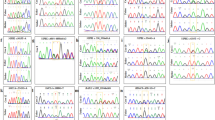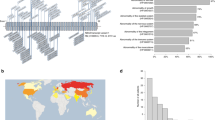Abstract
Alazami syndrome (MIM#615071) is a rare developmental disorder caused by biallelic variants in the LARP7 gene. Hallmark features include short stature, global developmental delay, and distinctive facial features. To date, 23 patients from 11 families have been reported in the literature. Here we describe a 19-year-old man who, in association with the typical features of Alazami syndrome, was diagnosed at the age of 14 years with papillary thyroid carcinoma, harboring the somatic BRAF V600E mutation. Whole exome sequencing revealed two novel LARP7 variants in compound heterozygosity, whereas only common variants were detected in genes associated with familial nonmedullary thyroid cancer (MIM#188550). LARP7 acts as a tumor suppressor in breast and gastric cancer, and possibly, according to recent studies, in thyroid tumors. Since thyroid cancer is rare among children and adolescents, we hypothesize that the LARP7 variants identified in our patient are responsible for both Alazami syndrome and tumor susceptibility. We also provide an overview of the clinical findings in all Alazami syndrome patients reported to date and discuss the possible pathogenetic mechanism that may underlie this condition, including the role of LARP7 in tumor susceptibility.
This is a preview of subscription content, access via your institution
Access options
Subscribe to this journal
Receive 12 print issues and online access
$259.00 per year
only $21.58 per issue
Buy this article
- Purchase on Springer Link
- Instant access to full article PDF
Prices may be subject to local taxes which are calculated during checkout




Similar content being viewed by others
References
Alazami AM, Al-Owain M, Alzahrani F, Shuaib T, Al-Shamrani H, Al-Falki YH, et al. Loss of function mutation in LARP7, chaperone of 7SK ncRNA, causes a syndrome of facial dysmorphism, intellectual disability, and primordial dwarfism. Hum Mutat 2012;33:1429–34.
OMIM [Internet]. Accessed 11Aug 2019. https://www.omim.org/.
Najmabadi H, Hu H, Garshasbi M, Zemojtel T, Abedini SS, Chen W, et al. Deep sequencing reveals 50 novel genes for recessive cognitive disorders. Nature. 2011;478:57–63.
Haugen BR, Alexander EK, Bible KC, Doherty GM, Mandel SJ, Nikiforov YE, et al. 2015 American Thyroid Association Management Guidelines for adult patients with thyroid nodules and differentiated thyroid cancer: The American Thyroid Association Guidelines task force on thyroid nodules and differentiated thyroid cancer. Thyroid 2016;26:1–133.
Guilmette J, Nosé V. Hereditary and familial thyroid tumours. Histopathology 2018;72:70–81.
Pekova B, Dvorakova S, Sykorova V, Vacinova G, Vaclavikova E, Moravcova J, et al. Somatic genetic alterations in a large cohort of pediatric thyroid nodules. Endocr Connect 2019;8:796–805.
Ye F, Gao H, Xiao L, Zuo Z, Liu Y, Zhao Q, et al. Whole exome and target sequencing identifies MAP2K5 as novel susceptibility gene for familial non-medullary thyroid carcinoma. Int J Cancer 2019;144:1321–30.
Dateki S, Kitajima T, Kihara T, Watanabe S, Yoshiura K, Moriuchi H. Novel compound heterozygous variants in the LARP7 gene in a patient with Alazami syndrome. Hum Genome Var 2018;5:18014.
Elmas M, Yıldız H, Erdoğan M, Gogus B, Avcı K, Solak M. Comparison of clinical parameters with whole exome sequencing analysis results of autosomal recessive patients; a center experience. Mol Biol Rep 2019;46:287–99.
Hollink IHIM, Alfadhel M, Al-Wakeel AS, Ababneh F, Pfundt R, De Man SA, et al. Broadening the phenotypic spectrum of pathogenic LARP7 variants: two cases with intellectual disability, variable growth retardation and distinct facial features. J Hum Genet 2016;61:229–33.
Holohan B, Kim W, Lai TP, Hoshiyama H, Zhang N, Alazami AM, et al. Impaired telomere maintenance in Alazami syndrome patients with LARP7 deficiency. BMC Genomics 2016;17:749.
Imbert-Bouteille M, Mau Them FT, Thevenon J, Guignard T, Gatinois V, Riviere JB, et al. LARP7 variants and further delineation of the Alazami syndrome phenotypic spectrum among primordial dwarfisms: 2 sisters. Eur J Med Genet 2019;62:161–6.
Karaca E, Harel T, Pehlivan D, Jhangiani SN, Gambin T, Coban Akdemir Z, et al. Genes that affect brain structure and function identified by rare variant analyses of mendelian neurologic disease. Neuron. 2015;88:499–513.
Ling TT, Sorrentino S. Compound heterozygous variants in the LARP7 gene as a cause of Alazami syndrome in a Caucasian female with significant failure to thrive, short stature, and developmental disability. Am J Med Genet Part A 2016;170:217–9.
Stavropoulos DJ, Merico D, Jobling R, Bowdin S, Monfared N, Thiruvahindrapuram B, et al. Whole-genome sequencing expands diagnostic utility and improves clinical management in paediatric medicine. npj Genom Med 2016;1:15012.
Wojcik MH, Linnea K, Stoler JM, Rappaport L. Updating the neurodevelopmental profile of Alazami syndrome: Illustrating the role of developmental assessment in rare genetic disorders. Am J Med Genet Part A 2019;179:1565–69.
Markert A, Grimm M, Martinez J, Wiesner J, Meyerhans A, Meyuhas O, et al. The La-related protein LARP7 is a component of the 7SK ribonucleoprotein and affects transcription of cellular and viral polymerase II genes. EMBO Rep 2008;9:569–75.
Egloff S, Studniarek C, Kiss T. 7SK small nuclear RNA, a multifunctional transcriptional regulatory RNA with gene-specific features. Transcription 2018;9:95–101.
He N, Jahchan NS, Hong E, Li Q, Bayfield MA, Maraia RJ, et al. A La-related protein modulates 7SK snRNP integrity to suppress P-TEFb-dependent transcriptional elongation and tumorigenesis. Mol Cell 2008;29:588–99.
Kreuger J, Spillmann D, Li JP, Lindahl U. Interactions between heparan sulfate and proteins: the concept of specificity. J Cell Biol. 2006;174:323–7.
Okamura D, Maeda I, Taniguchi H, Tokitake Y, Ikeda M, Ozato K, et al. Cell cycle gene-specific control of transcription has a critical role in proliferation of primordial germ cells. Genes Dev 2012;26:2477–82.
C. Quaresma AJ, Bugai A, Barboric M. Cracking the control of RNA polymerase II elongation by 7SK snRNP and P-TEFb. Nucleic Acids Res. 2016;44:7527–39.
Cheng Y, Jin Z, Agarwal R, Ma K, Yang J, Ibrahim S, et al. LARP7 is a potential tumor suppressor gene in gastric cancer. Lab Investig 2012;92:1013–9.
Ji X, Lu H, Zhou Q, Luo K. LARP7 suppresses P-TEFb activity to inhibit breast cancer progression and metastasis. Elife 2014;3:e02907.
Sui X, Sui Y, Wang Y. LARP7 in papillary thyroid carcinoma induces NIS expression through suppression of the SHH signaling pathway. Mol Med Rep 2018;17:7521–8.
Vanden Borre P, Schrock AB, Anderson PM, Morris JC, Heilmann AM, Holmes O, et al. Pediatric, adolescent, and young adult thyroid carcinoma harbors frequent and diverse targetable genomic alterations, including kinase fusions. Oncologist 2017;22:255–63.
Tate JG, Bamford S, Jubb HC, Sondka Z, Beare DM, Bindal N, et al. COSMIC: the catalogue of somatic mutations in Cancer. Nucleic Acids Res. 2019;47:D941–7.
Puli OR, Danysh BP, McBeath E, Sinha DK, Hoang NM, Powell RT, et al. The transcription factor ETV5 mediates BRAFV600E-induced proliferation and TWIST1 expression in papillary thyroid cancer cells. Neoplasia 2018;20:1121–34.
Uchikawa E, Natchiar KS, Han X, Proux F, Roblin P, Zhang E, et al. Structural insight into the mechanism of stabilization of the 7SK small nuclear RNA by LARP7. Nucleic Acids Res. 2015;43:3373–88.
Eichhorn CD, Chug R, Feigon J. hLARP7 C-terminal domain contains an xRRM that binds the 3′ hairpin of 7SK RNA. Nucleic Acids Res 2016;44:9977–89.
Zerbino DR, Achuthan P, Akanni W, Amode MR, Barrell D, Bhai J, et al. Ensembl 2018. Nucleic Acids Res. 2018;46:D754–61.
Acknowledgements
The authors thank ‘Fondazione Cassa di Risparmio Reggio Emilia Pietro Manodori’ for financial support. The authors would also like to thank the patient’s family for providing medical data and photographs, photographers Marco Bonazzi and Luca Valcavi, Federica Torricelli for bioinformatic counseling, and genetic nurse Maria Claudia Menozzi. The authors are deeply grateful to the Biobank of the Laboratory of Human Genetics (Director: Domenico Coviello) of the IRCCS Istituto Giannina Gaslini (Genova, Italy), a part of the Telethon Network of Genetic Biobanks. Written consent for publication of the clinical pictures was obtained from the patient’s parents.
Authors contribution
LG and II conceived the study. LG, II, EM, SR, MP, SP, DN, CB, AF, and SB were crucial for acquiring the patient’s clinical data. LM carried out whole exome sequencing and sequence alignment. SGC performed WES data analysis and variant confirmation testing. II, SGC, EM, SP, DN, CB, AF, LG, and OZ have been involved in drafting the paper and revising it critically. All the authors have given final approval.
Author information
Authors and Affiliations
Corresponding author
Ethics declarations
Conflict of interest
The authors declare that they have no conflict of interest.
Additional information
Publisher’s note Springer Nature remains neutral with regard to jurisdictional claims in published maps and institutional affiliations.
Supplementary information
Rights and permissions
About this article
Cite this article
Ivanovski, I., Caraffi, S.G., Magnani, E. et al. Alazami syndrome: the first case of papillary thyroid carcinoma. J Hum Genet 65, 133–141 (2020). https://doi.org/10.1038/s10038-019-0682-5
Received:
Revised:
Accepted:
Published:
Issue Date:
DOI: https://doi.org/10.1038/s10038-019-0682-5



